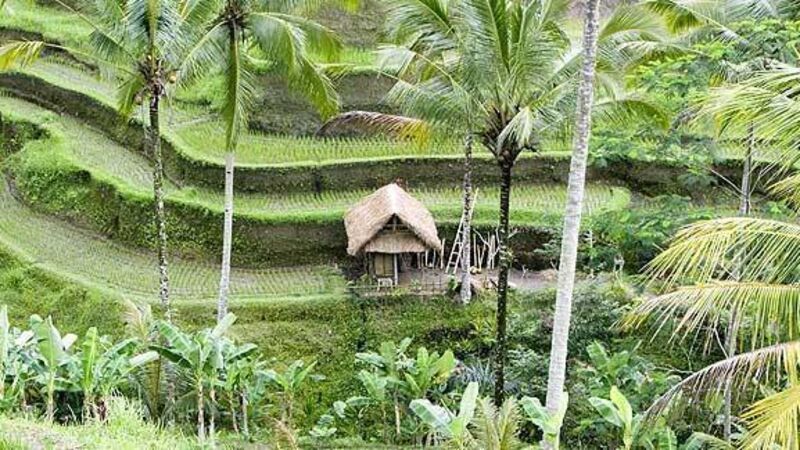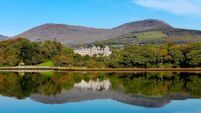Bali: More than just a beach destination

IT HAS uniquely ornate temples. Museums display art styles found only on the small island. And traditional ceremonies and festivals that can last several days occur regularly.
Ubud is Bali’s cultural heartland.
Pleasure seekers and those of a spiritual bent won’t be disappointed, either. Ubud is the place in Bali for dining and shopping. Enjoy a spa treatment, or a detox in luxuriant, tropical surroundings. Ubud — Ubad means “medicine” in Balinese — is also the centre for holistic practices and alternative therapies.
Ubud and the surrounding area offers many things that a tourist would want, except for a beach. That’s a 30-minute drive south to Sanur.
Painting, music, dance and sculpture in Bali originally served religious purposes. These arts continue to thrive, partly as a result of tourists purchasing or experiencing the island’s cultural assets.
“The Heart of Art in Bali,” the Neka Art Museum boasts on its brochure. Established by one person, and now a foundation, Bali’s premier museum is the best place to begin exploring what makes this tiny island’s art unique.
The paintings’ very informative English labels guide visitors through eras and art styles. Many of the larger paintings are dense with colour and life, ritual, myth, and everyday activities. Camera-toting tourists are portrayed in a comedic manner in some of the modern pieces. The works are beautifully displayed in traditional Balinese buildings within lovely grounds.
Besides an art museum, ARMA also offers cultural workshops in painting, Balinese batik, music, yoga and meditation, amongst others. While not as large as the Neka, it boasts a comprehensive collection of Balinese paintings and masterfully created ink works, both modern and traditional.
Check out the primates in the Sacred Monkey Forest Sanctuary if something more lighthearted sounds like a good idea after the serious business of art gazing. The long-tail macaques chow on tourist offerings, hang out, or play. They may jump on you if they suspect you’re carrying food. They also have a fondness for going through visitors’ hair. The protected troupes live around several temples in the small, dense and occasionally eerie, sanctuary. Should a male decide to leave, there is nowhere for them to go, unfortunately. Monkey Forest Road is smack bang in the middle of Ubud.
The Bali Bird Park, a short excursion south of Ubud, is particularly worth visiting if travelling with children. The free flying aviaries were the park’s best feature. The lovely Bali aviary, with its waterfall, pool and rich plant and tree life was a birds’ paradise. The endangered Bali starlings, a strutting peacock and very large, wide-awake bats hanging upside down on trees seemed to easily coexist. A stunning, multi-coloured, iridescent golden pheasant, lories, parrots and toucans reside in the Papua Aviary. A tree-top walkway provided views from above to the action below. A lone, immobile Komodo dragon, the world’s largest lizard, is also a resident of the bird park.
The neighbouring Reptile Park is included in the $23.50 adult ticket. A massive white and yellow albino Burmese python slept through the admiration. The king cobra almost exclusively eats other snakes and the giant tree frog makes a sound like a barking dog during the breeding season.
From monkeys in the flesh to rendering them in wood, the Setia Darma House of Masks and Puppets in Sukawati depicts Hanuman, the Hindu monkey God among the 1,300 masks and 5,600 puppets.
Vietnamese water puppets, Borneo string puppets, rare central Java grass puppets and one set of just four surviving Chinese-Javanese shadow puppets are some of the finds in this amazing collection. Entrance to the collection, which the retired antiques dealer had been amassing since 1980, is free.
Shopping in Ubud’s large, daily craft market is far from free, however. The asking prices for masks, puppets, paintings, etc, start at stratospheric prices for Indonesia. But prices quickly drop if the canny tourist feigns disinterest and begins to walk away. The final price can plummet by as much as 75% of what was initially sought.
Many Balinese are paid about €4 per long working day and the real local cost of living is correspondingly low. Almost every purchase and transaction has to be negotiated. There are the often sky-high tourist rates — and the actual, local, rate. Many Balinese, unfortunately, view tourists as walking ATMs. Children (illegally) ride motorbikes to school when previously they cycled. Their parents drive hugely unsuitable four-wheel vehicles on narrow, winding roads. Traffic congestion has become a way of life in Ubud and the bigger towns on this tiny island.
A walk amongst the rice paddies is the perfect antidote to Ubud’s commercial side. The almost circular, easy three hour walk begins and ends in Ubud Kaja, in the town’s northern part. Begin at 7am to avoid the intense heat. Most of the route alongside the terraced rice fields is paved.
The unpaved, well-trodden trail is also simple, as it follows a river and meanders through a small forest. Drops of water glistened on the tops of emerald green blades of grass in the early morning sunshine. It was a magical sight. Forty shades of green came to mind, observing the fantastic variety of flora along the way. Carry water, wear a sunhat and sturdy sandals. And enjoy the rural side of Ubud.
Visit Gunung Kawi and Tirta Empul for a spiritual experience of a different ilk. The 11th century carved royal memorials, beside the sacred Pakrisan River, is much quieter than many other archaeological sites. Descend 315 steps, wearing a borrowed sarong, to see the huge carved reliefs that resemble temple facades. The Four Queens’ Tombs are believed to be King Anak Wungsu’s consorts. The five royal ‘tombs’ on the other side of the river probably honour the king and his queens. As no bones or ashes have been found behind the chiselled, cliffside reliefs, they may not have been actual tombs, yet inscriptions, thought to be names or titles, are found over each false door.
Balinese from near and far visit Tirta Empul, two kilometres away. They come to spiritually cleanse themselves and cure their physical ailments by bathing in the holy springs. It has been the holiest waters on the island since the 10th century. The sunken pools, in the grounds of a temple’s outer courtyard, contain segregated sections for men, women and priests to bathe themselves.
A sudden, torrential downpour provided the perfect opportunity to sit and eat readymade noodles in the simple restaurant, beside the large pond filled with coy and gold-coloured fish.
After the cooling rains finished, it was time to return to Ubud for more exploring.
Fly Dublin-London-Kuala Lumpur-Denpassar, Bali, with Malaysian Airlines from €650 return, including taxes and fees. The fare is valid for travel up to early December. These fares must be booked online: www.gohop.ie.
Accommodation, like dining in Ubud, ranges from backpacker-style places to super de luxe. !
Tegal Sari: Views of rice paddy fields and great recommendations on Trip Advisor. This place is always booked, it seems. Single/double room rates start from Rp 330,000 (€20), www.tegalsari-ubud.com.
Ubud Sari Health Resort: A long-established health resort that primarily offers detox programmes in lovely surroundings. Rooms start from $50. www.ubudsari.com
Wapa di Ume: A village-like exterior with rustic, but chic, interiors. And far from the madding Ubud crowds, yet still within walking distance. Room rates start from: $217. www.wapadiume.com
For local food that’s ready to eat take your pick from single main items like chicken for Rp 10,000 at Puteri Minang, a Padang restaurant at Jalan Raya Ubud, 77.
There’s great Barbeque ribs, beer on draught and a lively atmosphere at Naughty Nuri’s, directly opposite Neka Museum, on Jalan Raya Sanggingan. For a special treat, check out Ubud’s best restaurant, Mozaic. The six course, Rp 700,000 Discovery Menu features local produce with the chef’s magical twist.www.mozaic-bali.com.










